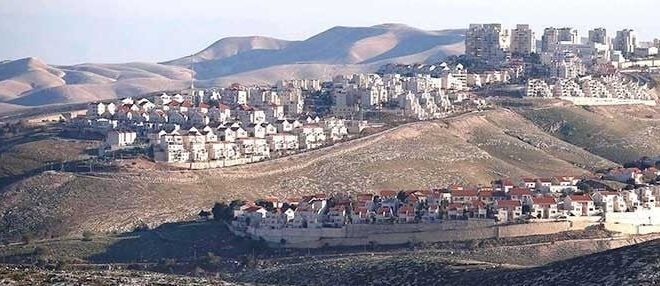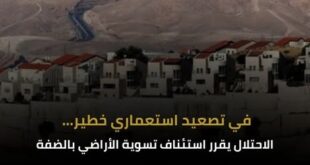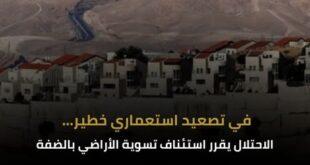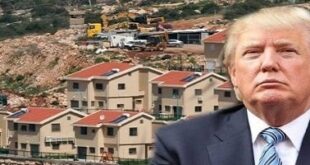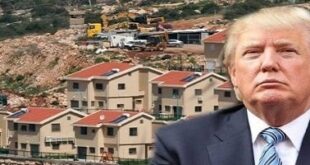By: Madeeha Al-A’raj
The National Bureau for Defending Land and Resisting Settlements stated in its latest weekly report , that Netanyahu, Smotrich and Ben-Gvir Government is stepping up its unprecedented settlement offensive in the occupied West Bank, including East Jerusalem, seizing vast areas of land in areas B & C, and besieging Palestinians in enclaves the ways that were existed in South Africa during the obsolete apartheid regime, where the earth mounds, cement blocks, and iron gates are erected throughout the Palestinian countryside. Accordingly, the Palestinian farmers’ access to their lands and fields has become fraught with great danger, especially after the settlers spread their settlement outposts and terrorist pastoral farms extensively around these towns and villages, and after the occupation, according to UNs’ data, deployed more than 849 military checkpoints manned by an army of settlers in the occupation army’s reserve forces.
The area of Palestinian land accessible to Palestinian farmers has shrunk dramatically, while the living space of settlements has expanded to include olive groves, pastureland, and water springs. The area of pastureland, which Palestinian citizens used to graze their flocks and livestock, has dwindled, and so livestock, while the springs, which citizens relied on to fill the water shortage for domestic use or to water their flocks, have been transformed by settlers into hiking trails or swimming pools. Furthermore, the occupation government continues to provide everything necessary for the thieving project of seizing Palestinian land for the benefit of its settlement plans.
In its latest report issued last week, the Palestinian Central Bureau of Statistics – (PCBS) summarized the policy of seizing Palestinian lands, confirming that during 2024, the occupation issued about 35 orders to seize 1,073 dunums, 5 expropriation orders of 803 dunums, 9 orders to declare 24,597 dunums as Sate lands, and 6 orders to modify the boundaries of nature reserves. Thus, the occupation seized about 20,000 dunums, as part of the systematic and ongoing policy to control all Palestinian lands.
For its part, the UN acting Special Coordinator for the Middle East Peace Process, Sigrid Kag, confirmed that the continued expansion of Israeli settlements is dramatically altering the landscape and demographic composition of the occupied West Bank, including East Jerusalem. She emphasized that Palestinians are increasingly confined to shrinking and disconnected areas, posing an existential threat to the possibility of establishing a contiguous, viable, and independent Palestinian state.
This came during her briefing to the UN Security Council on the implementation of Resolution 2334, which called on Israel to immediately cease all settlement activities in the occupied Palestinian territory. Kag noted that during 7 Dec 2024 – 13 March 2025, settlement activity continued at a high rate, with Israel advancing or approving 10,600 housing units in settlements in the occupied West Bank, including 4,920 units in East Jerusalem. Meanwhile, it demolished, seized, sealed off, or forced people to demolish 460 Palestinian structures, displacing 576 people, half of them are children.
The Israeli Peace Now movement described the new situation in its latest report as follows: ‘The year 2024 is characterized by a policy of shrinking Palestinian space in Areas B and C and expanding Israeli presence there. In fact, this year will witness the greatest decline in Palestinian presence and rights in the West Bank, with unprecedented weakness in law enforcement against settlers regarding construction violations and violence against Palestinians. This situation is exacerbated by budget transfers, building permits, and the legalization of outposts, all of which are unprecedented in the history of the settlement enterprise.
This policy is implemented through the establishment of a record number of illegal outposts, unprecedented road construction, a sharp increase in the quantity and intensity of settler violence, which the head of the Shin Bet has described as terrorism, in addition to road closures (to Palestinians), and a record in the legalization and financing of illegal outposts. Since the formation of the current government, Israel has completed the establishment of the administrative infrastructure necessary to effectively annex the West Bank to Israel, transferring powers from the Civil Administration to a political and civil body under Minister Smotrich.’
The Peace Now added, ‘the occupation authorities established at least 59 new settlement outposts, most of them agricultural outposts ‘farms’ involved in the land grab and systematic expulsion of Palestinians from the area. This is an unprecedented number of new settlement outposts. For comparison, from 1996 to the beginning of 2023 an average of less than 7 settlement outposts were established each year. Outposts in Area B: For the first time since the Oslo Accords, at least 8 settlement outposts were established in Area B. This means that at least 13% of the total settlement outposts established in the West Bank in 2024 were located in Area B. Many illegal roads, more than 114 km were paved to expand settlements and seize additional land.’
In 2024, the Israeli Cabinet decided to establish and legalize 5 new settlements in the West Bank: Eviatar in the Nablus Governorate, Givat Asaf and Sde Efraim in the Ramallah Governorate, Adoraim in the Hebron Governorate, and Nahal Helitz in the Bethlehem Governorate. The process of legalizing 5 additional outposts began as neighborhoods of existing settlements, and the Civil Administration announced its intention to expand the jurisdiction of settlements to include the outposts of Ahiya, Beit Eliyahu, and Bnei Adam. About 70 illegal outposts were retroactively recognized as eligible for funding and infrastructure. In light of this, Minister Smotrich instructed government ministries and other bodies to begin funding these illegal outposts, in addition to constructing public buildings in them and linking them with water, electricity, and other utilities.
A few days ago this year, the security cabinet approved a proposal submitted by the Minister of Settlement in the Ministry of Army, Smotrich, which stipulates separating 13 settlements in the West Bank from the settlements adjacent to them, and beginning the process of recognizing them as independent settlements. The settlements covered by the decision are distributed across a number of governorates, 4 of them in the Ramallah and al-Bireh Governorate: ‘Horsha” and ‘Kerem Re’im’ on the lands of Al-Mazra’a Al-Gharbiyya, ‘Neria’ to the east of the village of Deir Ammar, and ‘Migron’ between the settlements of Ofra and Beit El.
One in the Nablus Governorate: ‘Shvut Rachel’ on the lands of the villages of Jalud and Qaryut. One in the Jenin Governorate: ‘Tal Menashe’ on the lands of Um Al-Rihan. Four in the Bethlehem Governorate: ‘Alon and Efe Hanahal on the lands of the village of Kisan and Gva’ot’. Two are located in the Salfeet Governorate: ‘Leshem on the lands of Deir Ballut in the Salfeet Governorate, ‘Nofei Nahmia’ on the lands of Sakaka and Yasuf, and one in the Tubas Governorate: ‘Brush Hapiqa – Batronot’.
The Occupation Gov’t is moving forward with the construction of roads aiming to expand settlements and increasing the number of settlers. These include infrastructure works on Highway 60 between Jerusalem and Gush Etzion, Highway 437 between Jerusalem and the Sha’ar Binyamin Industrial Zone, the construction of the Sheikh Anbar tunnel in the At-Tur neighborhood in East Jerusalem as part of the Eastern Ring Road, and the paving of the bypass road to Lovon (Highway 465), including a new access road to the settlement of Beit Arye in the Ramallah Governorate and al-Bira. In addition, land expropriation orders have been issued for the development and expansion of Highway 55 between the Green Line and Alfei Menashe in the Qalqilia Governorate.
Highway 505 between Ariel and the Za’tara Junction in the Salfeet Governorate, and Highway 60 between Halhul and Sa’ir in the Hebron Governorate, where NIS 409,000,000 has been allocated for settlement projects following comprehensive budget cuts. This includes projects to preserve antiquities in the West Bank, the restoration of the Sebastia Park in the Nablus Governorate, the reinforcement of the Old City Basin (a tourist settlement in East Jerusalem), and projects related to the Elad settlement association in Silwan, to finance illegal outposts and farms, NIS 75 million was allocated, including about NIS 39,000,000 for illegal shepherd farms, which serve as greenhouses for settler terror.
Within the context, the Supreme Planning Council is currently discussing approval for the construction of 1,344 housing units, including 1,113 in the Ma’ale Adumim settlement and 231 in Kochav Ya’akov, where the total number of settlement units on the council’s agenda to is 11,511 units since the beginning of 2025. This comes in light of the changes made by the Netanyahu-Smotrich government in June 2023, which abolished the requirement for the army minister’s approval for each stage of the settlement plan’s development.
Earlier, every construction plan in the settlements required prior approval from the army minister. Recently, we have witnessed a change, with the Supreme Planning Council meeting weekly and approving hundreds of housing units at each meeting. In this way, the government seeks to normalize planning in the settlements and reduce public and international attention and criticism.
The Israeli organization Kerem Navot that monitors and researches the land policies of the Israeli authorities in the West Bank, and the well-known Peace Now Movement recently published a joint report revealing how a small group of violent settlers, with the support of the Israeli government, has taken control of 14% of the West Bank by establishing scores of pastoral farms ‘estimated 100)’, effectively displacing Palestinians from these areas. The report highlights how the government has enabled these settlers through extensive land allocations and millions of shekels in funding.
The report reveals that settlers have used the pastoral farms to seize at least 786,000 dunams of land, equivalent to 14% of the total area of the West Bank. Israeli settlers, supported by the Israeli government and military, use three main methods to seize land: establishing pastoral outposts; displacing Palestinian shepherds and farmers from their lands, harassing, intimidating, and violently targeting neighboring Palestinian communities to force their displacement; and seizing vast areas of land from displaced Palestinian communities and establishing new settlement outposts, using such methods, settlers have displaced more than 60 Palestinian pastoral communities and established many settlement outposts and farms on their lands.
According to the report, an analysis of the lands seized by settlers shown that the majority of them aren’t classified as State land, even according to Israel’s own definitions. The occupation army has classified 41% of the seized lands as firing zones, restricted areas where civilians who are not permanent residents, including settlers, are officially prohibited from entering. In addition, 4.4% of the lands seized by settlers through outposts fall within areas A and B, which are under the Palestinian Authority. The Israeli government’s support for these pastoral farms goes beyond this, with a financial system that transfers tens of millions of shekels annually to these illegal settlement outposts.
This includes, tens of millions of shekels under the budget line for security needs, as well as funding for road paving, solar panels, electric gates, vehicles, drones, cameras, generators, lighting poles, and similar funds for patrol units. The government funds salaries, equipment, vehicles, drones, aerial photography and infrastructure projects, including the construction of roads and fences, fixing monitoring cameras, and electric gates, and other grants, such as, herding grants and entrepreneurship grants. This is in addition to the millions of shekels that the Amana settlement movement funnels into the outposts associated with violence against Palestinians, and the millions of shekels that the Jewish National Fund spends on pastoral outposts, under the pretext of funding volunteer programs to support at-risk youth.
List of Israeli Assaults over the Last Week Documented by the National Bureau:
Hebron:
- Chasing shepherds in the Tal Ma’in area in Masafer Yatta and forcibly prevented them from reaching their pastures.
- Demolishing Ramadan Nayef al-Rajabi’s house in the Khallet-Eidah before the legal deadline for objecting to the demolition order expired, and handed demolition and stop-work orders for 6 houses in the Idhna town, west of Hebron.
- Attacking shepherds and assaulted Mah’d Khalil Abu Aram In Khirbet al-Halawa in Masafer Yatta,, breaking his phone. They also attempted to steal a herd of livestock belonging to the family.
Bethlehem:
- Demolishing a 50 squaremeter inhabited house belonging to Taha Moh’d Awadallah and an agricultural room belonging to his brother Ahmed under the pretext of not having a license in the village of Al-Walaja. The demolition was followed by raids on the areas of Khallet Al-Naflah, Al-Sarj and Al-Khour in the village, and demolition orders were delivered to 5 inhabited three-story houses under the same pretext.
- Notifying to demolish a horse stable belonging to Ali Nasrallah Al-Amur, and the bulldozing of agricultural lands belonging to Zakaria Mahmoud Al-Araj and Hamed Saleh Hajajleh in the Al-Minya desert, attacked shepherds and tried to seize a number of sheep, but the citizens confronted them and prevented them.
- Seizing a number of camels estimated at 9, including those belonging to Ayoub Ahmed Rashaideh in the Al-Rashaydeh town.
Nablus:
- Chopping a number of olive trees on land belonging to Shehadeh Jamil Rawajbeh in the Rujeib village.
- Storming the archaeological site in the Sabastia town, under the leadership of the head of the settlement council in the northern West Bank, Yossi Dagan, and under the protection of the occupation army.
Qalqilia:
- Demolishing a 200-square-meter cattle breeding facility belonging to Nael Masalha in the eastern part of Al-Funduq village, east of Qalqilya, on the pretext that located in Area C.
Tulkarem:
- Issuing order for 3 houses in the Ras al-Shomer area of Kafr al-Labad, east of Tulkarm. The homes are belonging to Adel Thaltheen, Ahlam Yahya Abdel Qader, and Yousef Ahmed Salim al-Ghoul.
Jenin:
- Demolishing commercial warehouses in the Mansoura village, south of Jenin, on the road between Nablus and Jenin, on the pretext of not having a permit.
- Demolishing 3 commercial stores in the Barta’a town, northwest of Jenin.
Jordan Valley:
- Setting up a hut near citizens’ tents in Ein al-Hilweh in the northern Jordan Valley, while others stormed the Al-Auja waterfall gathering and grazed their sheep among citizens’ homes under the protection of the occupation forces.
- Plowing an area of 200 dunums of agricultural land, and others assaulted the citizen Yazan Murad Daraghmeh and one of the solidarity activists present in the Al-Farisiya village. Meanwhile, settlers released their livestock into the rain-fed crops of citizens in the “Al-Maytah” area in the northern Jordan Valley, while other settlers brought a herd of cows near the citizens’ tents in the same area.
 المكتب الوطني للدفاع عن الارض ومقاومة الاستيطان منظمة التحرير الفلسطينية
المكتب الوطني للدفاع عن الارض ومقاومة الاستيطان منظمة التحرير الفلسطينية
